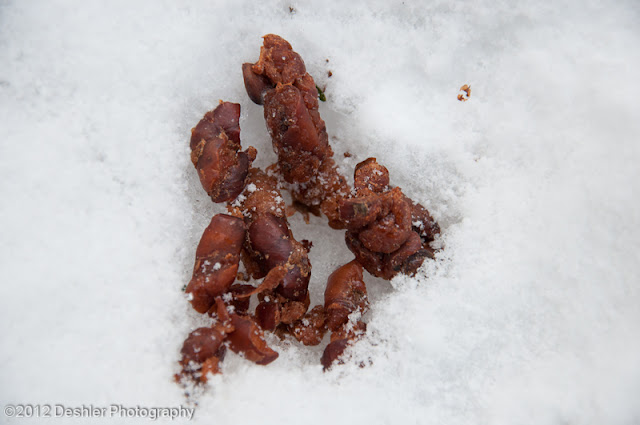We spent most of our time tracking in a hemlock forest, this time of year it is easy to move through, but during the summer months this forest is wet and difficult to navigate.
At first when I came upon the tracks that crossed the main trail, I wasn't sure if it was a fisher cat or red fox. The tracks were hard to distinguish, but I soon found out they were tracks of the fisher. First, they are wider and have a fifth toe and the gait is a bound rather than a walking gait (fisher cats will also walk). Second, the tracks walked along logs and tip-up mounds of dead trees. They also walked under blow downs in tight spaces. This is not typical of the red fox.
I made sure to back track the animal (following the tracks backwards), as fisher cats are active both day and night. I didn't want to be chasing the animal, forcing it to use up its winter energy reserves. Above you can see where the fisher jumped onto the stump and back to the ground.
We found a knee to an unfortunate animal (deer, cow, moose?) that had been dragged into the forest. It looked as though the fisher stopped and gnawed on the left over flesh and then went on its way.
We were excited to find its scat on a log. Canines and other animals will defecate on top of higher surfaces to show other animals they've been there.
We studied the scat, but couldn't figure out what its origins were. Fishers are omnivores and will eat animals, insects, and plants; their specialty being porcupines. But there was no sign of animals in this scat. We later found out its origin as the fisher led us to its feeding ground.
Once we crossed the main trail, the tracks led closer to the river and we found a scent marker. There was scratching and remnants of a light yellow stain that sure smelled like urine!
Yet another scat, deposited on an old hemlock stump.
Closer to the river, the tracks led us to this open area. Tracks were everywhere! Most of them were deer. Jim wondered aloud, "Why are there so many tracks here compared to anywhere else?" Answer - look up to the sky:
Apples! These open areas with old apple trees are great places for wildlife to feed. Deer, fox, coyote, squirrel, and fisher cat will all partake in the bounty. This year was a bumper crop for apples and many seed trees.
In the photo above you can see where the squirrel sat and chewed on the apple. Now we know what was in the fisher scat, and it wasn't the squirrel.
We decided to end our tracking at the apple field and travel back to the main trail. Not far into our walk back to the car we found more coyote scat and a new scat that may have been from the red fox. It's good to know that this conserved land can provide an opportunity not only for working farm and forestland, but also a thriving wildlife population.
Click here for more information and directions to: BUCT













No comments:
Post a Comment